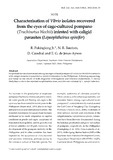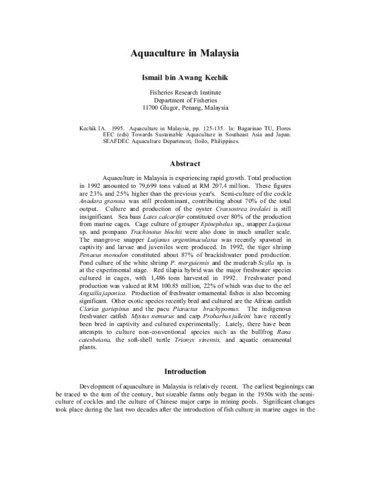Field evaluation of hydrogen peroxide bath technique for controlling sea lice (Lepeoptheirus spinifer) infestation in snubnose pompano (Trachinotus blochii)
| dc.contributor.author | Erazo-Pagador, Gregoria | |
| dc.contributor.author | Tesorero, Michael | |
| dc.contributor.author | Caloyloy, Blan Jericho | |
| dc.coverage.spatial | Guimaras | en |
| dc.coverage.spatial | Philippines | en |
| dc.date.accessioned | 2024-06-19T06:11:30Z | |
| dc.date.available | 2024-06-19T06:11:30Z | |
| dc.date.issued | 2024-08 | |
| dc.identifier.citation | Erazo-Pagador, G., Tesorero, M., & Caloyloy, B. J. (2024). Field evaluation of hydrogen peroxide bath technique for controlling sea lice (Lepeoptheirus spinifer) infestation in snubnose pompano (Trachinotus blochii). Veterinary Parasitology, 330, 110223. https://doi.org/10.1016/j.vetpar.2024.110223 | en |
| dc.identifier.issn | 0304-4017 | |
| dc.identifier.uri | http://hdl.handle.net/10862/6537 | |
| dc.description.abstract | Sea lice infestations can pose significant challenges in the aquaculture sector, affecting fish health and overall production. In the search for effective and eco-friendly solutions, hydrogen peroxide bath treatment has been considered as one of the promising methods. This is the first study to evaluate the field efficacy of hydrogen peroxide bath technique against sea lice infestation on cage-cultured snubnose pompano (Trachinotus blochii). Sea lice was identified as Lepeophtheirus spinifer using morphological description. Naturally-infested snubnose pompano stocked in 2 × 3 × 2 m3 net cages at 15 fish/cage at the Igang Marine Station of SEAFDEC/AQD, in Guimaras, Philippines were treated in triplicates with two hydrogen peroxide concentrations (1500 and 2000 ppm) in comparison to a control (seawater only) for 20 minutes at 32.8 ± 0.7 ppt and 28.9 ± 0.3 °C and were monitored at 3rd and 7th day post-treatment. The total mean intensity of sea lice, mean intensity per life stages (copepodid, chalimus I, chalimus II, pre-adult I, pre-adult II, adult male and adult female), and the 12-h viability of scraped male and adult female L. spinifer from the treatment groups were evaluated. The total mean intensity of sea lice in the treated groups at 3 day post-treatment was significantly lower than the control group (p < 0.001). A possible re-infection of sea lice was observed 7 days post-treatment as explained by the slight increase in the mean intensity in the treated groups. However, no mortalities of pompano were recorded throughout the experiment. In addition, adult female lice were absent in the treated group while adult male lice were only detected in the 1500 ppm treatment group at a very low mean intensity. The viability test also showed that all sea lice were not able to recover after 12 h whereas a 100 % recovery rate was noted in the control group. Results suggest that the 1500 and 2000 ppm hydrogen peroxide concentrations are effective in reducing sea lice infestation on cage-cultured snubnose pompano. However, a long-term effect of hydrogen peroxide treatment on sea lice needs further investigation. | en |
| dc.description.sponsorship | The authors thank the Technology Verification and Extension Division (Study Code: TV-08-F2021I) of SEAFDEC/AQD for funding this study. | en |
| dc.language.iso | en | en |
| dc.publisher | Elsevier | en |
| dc.subject | pompanos | en |
| dc.subject | Trachinotus blochii | en |
| dc.title | Field evaluation of hydrogen peroxide bath technique for controlling sea lice (Lepeoptheirus spinifer) infestation in snubnose pompano (Trachinotus blochii) | en |
| dc.type | Article | en |
| dc.identifier.doi | 10.1016/j.vetpar.2024.110223 | |
| dc.citation.volume | 330 | en |
| dc.citation.spage | 110223 | en |
| dc.citation.journalTitle | Veterinary Parasitology | en |
| dc.subject.asfa | infestation | en |
| dc.subject.asfa | aquaculture | en |
| dc.subject.asfa | fish diseases | en |
| dc.subject.asfa | health | en |
| dc.subject.scientificName | Lepeophtheirus spinifer | en |
| dc.subject.scientificName | Trachinotus blochii | en |
| local.subject | Lepeophtheirus spinifer | en |
| local.subject | snubnose pompano | en |
| local.subject | hydrogen peroxide | en |
| dc.subject.sdg | SDG 14 - Life below water | en |
| dc.subject.sdg | SDG 17 - Partnerships for the goals |
このアイテムのファイル
| ファイル | サイズ | フォーマット | 閲覧 |
|---|---|---|---|
|
このアイテムに関連するファイルは存在しません。 |
|||
このアイテムは次のコレクションに所属しています
-
Journal Articles [1256]
These papers were contributed by Department staff to various national and international journals.




